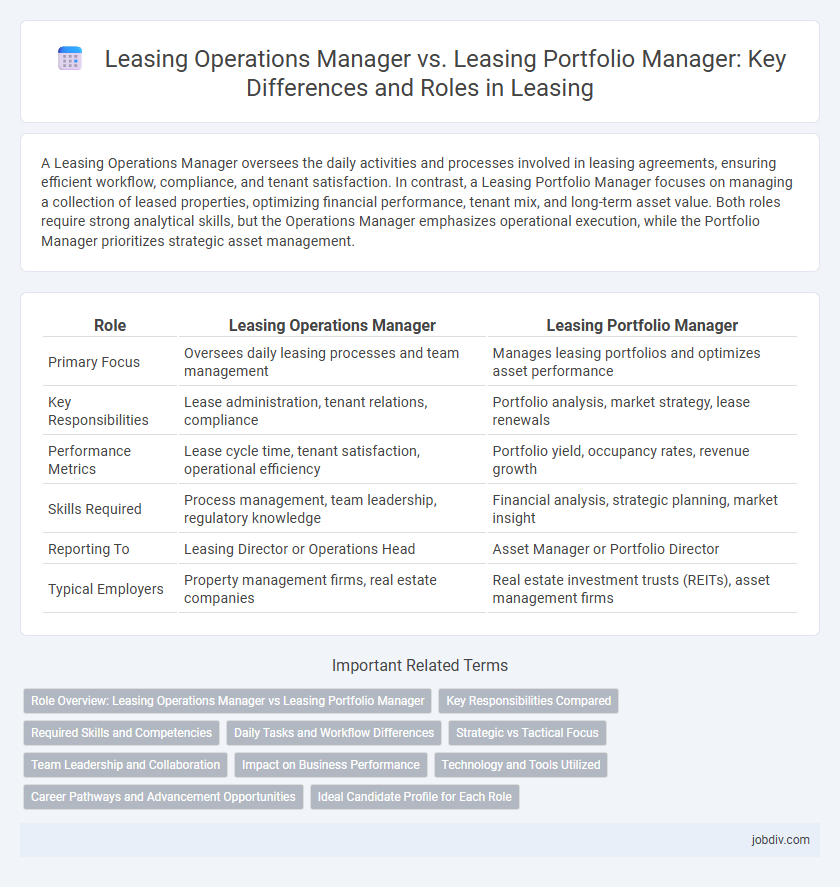A Leasing Operations Manager oversees the daily activities and processes involved in leasing agreements, ensuring efficient workflow, compliance, and tenant satisfaction. In contrast, a Leasing Portfolio Manager focuses on managing a collection of leased properties, optimizing financial performance, tenant mix, and long-term asset value. Both roles require strong analytical skills, but the Operations Manager emphasizes operational execution, while the Portfolio Manager prioritizes strategic asset management.
Table of Comparison
| Role | Leasing Operations Manager | Leasing Portfolio Manager |
|---|---|---|
| Primary Focus | Oversees daily leasing processes and team management | Manages leasing portfolios and optimizes asset performance |
| Key Responsibilities | Lease administration, tenant relations, compliance | Portfolio analysis, market strategy, lease renewals |
| Performance Metrics | Lease cycle time, tenant satisfaction, operational efficiency | Portfolio yield, occupancy rates, revenue growth |
| Skills Required | Process management, team leadership, regulatory knowledge | Financial analysis, strategic planning, market insight |
| Reporting To | Leasing Director or Operations Head | Asset Manager or Portfolio Director |
| Typical Employers | Property management firms, real estate companies | Real estate investment trusts (REITs), asset management firms |
Role Overview: Leasing Operations Manager vs Leasing Portfolio Manager
Leasing Operations Managers oversee daily operational activities, ensuring smooth lease administration, tenant coordination, and compliance with leasing policies. Leasing Portfolio Managers focus on strategic asset management, optimizing the leasing portfolio's performance through market analysis, lease negotiations, and financial forecasting. The Leasing Operations Manager prioritizes process efficiency and tenant relations, while the Leasing Portfolio Manager drives portfolio growth and investment returns.
Key Responsibilities Compared
A Leasing Operations Manager primarily oversees daily leasing activities, ensuring efficient tenant management, lease compliance, and coordination between leasing agents and property maintenance teams. In contrast, a Leasing Portfolio Manager focuses on strategic oversight of multiple properties, optimizing lease renewals, and maximizing portfolio revenue through market analysis and tenant retention strategies. Both roles require strong negotiation skills, but the Operations Manager emphasizes operational execution while the Portfolio Manager prioritizes portfolio performance and long-term growth.
Required Skills and Competencies
Leasing Operations Managers require strong organizational skills, proficiency in lease administration, and expertise in regulatory compliance to ensure smooth day-to-day lease processes. Leasing Portfolio Managers need advanced analytical abilities, financial acumen, and portfolio management skills to optimize asset performance and maximize lease revenue. Both roles demand excellent communication, negotiation skills, and knowledge of leasing software, but the Portfolio Manager places greater emphasis on strategic planning and risk assessment.
Daily Tasks and Workflow Differences
A Leasing Operations Manager focuses on overseeing daily leasing procedures, coordinating tenant communications, managing lease documentation, and ensuring compliance with company policies and legal standards. In contrast, a Leasing Portfolio Manager handles a broader scope by analyzing portfolio performance, strategizing lease renewals, optimizing asset utilization, and collaborating with finance teams to maximize ROI across multiple properties. Their workflows differ in that Operations Managers engage in hands-on, transactional tasks, while Portfolio Managers prioritize analytical and strategic decision-making to enhance overall portfolio value.
Strategic vs Tactical Focus
A Leasing Operations Manager primarily focuses on tactical execution, managing day-to-day leasing processes, tenant relations, and lease documentation to ensure seamless operations. In contrast, a Leasing Portfolio Manager adopts a strategic focus, overseeing a collection of lease agreements to optimize portfolio performance, analyze market trends, and drive long-term asset growth. The Operations Manager ensures operational efficiency while the Portfolio Manager aligns leasing strategies with broader business goals for maximum return on investment.
Team Leadership and Collaboration
Leasing Operations Managers oversee daily leasing processes, ensuring efficient workflow and direct supervision of leasing agents to drive team performance. Leasing Portfolio Managers focus on strategic collaboration across departments to optimize property portfolios and maximize lease revenue. Strong leadership in Leasing Operations centers on operational execution, while Leasing Portfolio Managers emphasize cross-functional teamwork and portfolio growth.
Impact on Business Performance
A Leasing Operations Manager drives business performance by optimizing leasing processes, ensuring compliance, and enhancing tenant satisfaction through efficient contract management. A Leasing Portfolio Manager impacts performance by strategically managing a portfolio of properties, maximizing rental income, and reducing vacancy rates through targeted leasing strategies. Both roles contribute to revenue growth but differ in focus; Operations Managers emphasize process efficiency, while Portfolio Managers prioritize asset performance and market positioning.
Technology and Tools Utilized
Leasing Operations Managers primarily utilize property management software like Yardi and MRI to streamline lease administration, track tenant communications, and manage maintenance requests efficiently. Leasing Portfolio Managers often employ advanced analytics platforms and CRM systems such as Salesforce combined with AI-driven forecasting tools to optimize portfolio performance and maximize rental income. Both roles increasingly integrate cloud-based solutions and mobile applications to enhance real-time data access and operational agility.
Career Pathways and Advancement Opportunities
Leasing Operations Managers typically oversee day-to-day leasing activities and team coordination, building foundational skills in property management and tenant relations, which prepares them for broader operational roles. Leasing Portfolio Managers, managing multiple properties or portfolios, focus on strategic asset performance, financial analysis, and long-term planning, positioning themselves for senior leadership roles such as Director of Asset Management or VP of Real Estate. Career advancement frequently transitions from hands-on operational roles to strategic management, requiring expanded expertise in market trends, financial metrics, and portfolio optimization.
Ideal Candidate Profile for Each Role
The ideal Leasing Operations Manager possesses strong organizational skills, expertise in contract management, and proficiency in coordinating leasing activities to ensure smooth operational workflows and tenant satisfaction. The Leasing Portfolio Manager excels in financial analysis, portfolio optimization, and strategic planning to maximize rental income and asset value across diverse property holdings. Both roles require excellent communication and negotiation skills, but the Operations Manager focuses on day-to-day lease administration while the Portfolio Manager emphasizes long-term investment performance and portfolio growth.
Leasing Operations Manager vs Leasing Portfolio Manager Infographic

 jobdiv.com
jobdiv.com